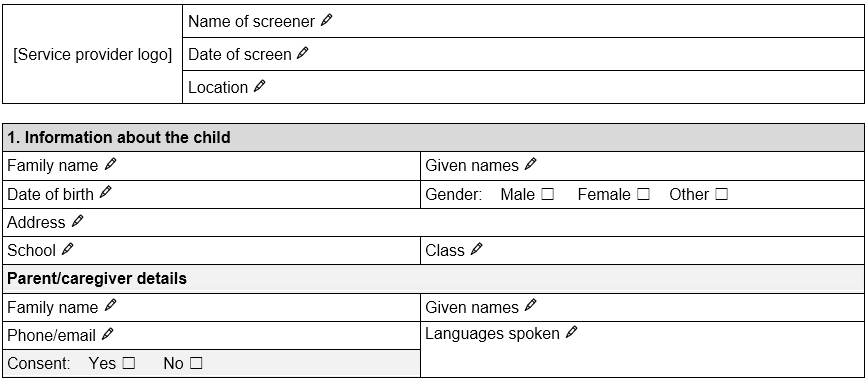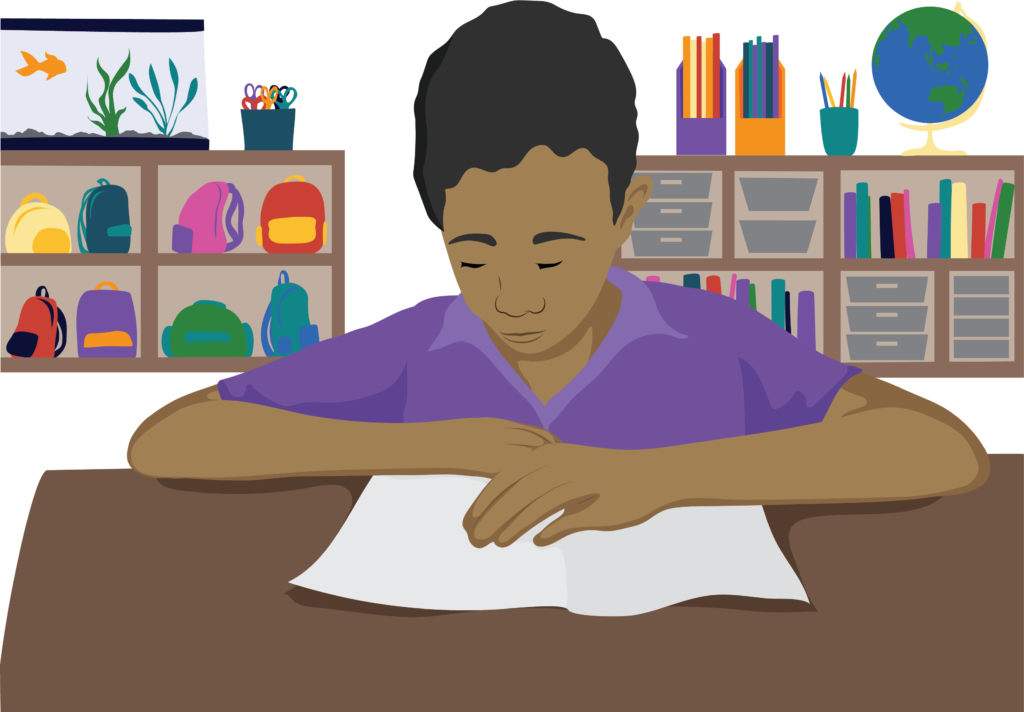Screen form
The Screen form will support you to carry out sensory screening with each child and make a plan.
Instruction
If you haven’t already, download the Screen form and print a copy.
If you are unable to download the form, don’t worry. Questions on the form are shown as you go through this section of the module.
Start by recording:
- Name of screener
- Date of screen
- Location where screening is taking place.

Gather information
- Greet the child and ask them for their name and class number
- Find their Consent form.
Tip
If the child did not attend the group preparation session, explain what you will be doing.
Information about the child
The first part of the Screen form involves collecting information about the child, their parent/caregiver and consent to carry out the screen.
Complete the first section of the Screen form by copying across the information from the Consent form.
Information about the child includes their name, date of birth, address, school and class.
Parent/caregiver details include name, contact phone and/or email and languages spoken.
Question
Why is it helpful to know languages spoken by a child’s parent/caregiver?
It is important to notify the parent/caregiver about the results of their child’s sensory screening in their spoken language.
Consent
Confirm if the child has consent from their parent/caregiver to take part in the screening.
Only continue if consent is given.
Pre-screening questions

Instruction
- Check the pre-screening questions
- Copy the information from the completed consent form.
If the pre-screening questions have not been answered continue to carry out the vision screen.
Spectacles
Instruction
Check if the child wears spectacles.
If Yes, this means that they are already being seen by eye care personnel.
If Yes and a problem is identified during screening Refer to eye care personnel at service child is already using.
Instruction
If the child has spectacles, check what they are used for:
- Seeing things in the distance
- Seeing things that are near.
Question
When would you ask a child to keep their spectacles on during a distance vision screen?
Select two.
If you selected a and c, you are correct!
It is important to screen the child’s vision while wearing their distance spectacles to make sure they are working well.
Wearing spectacles that are, or might be used for near vision problems, will lead to an incorrect (false) distance vision screen result.
If the child:
- Does not have spectacles continue
- Wears spectacles for seeing in the distance ask the child to wear spectacles for screening
- Wears spectacles for seeing things that are near or does not know ask the child not to wear spectacles for screening.
Hearing aids
Instruction
Check if the child wears hearing aids.
- If No continue
- If Yes and a problem is identified during screening Refer to ear care personnel at service child is already using.
Diabetes and eye health
Instruction
Check if child has diabetes or parent/caregiver has concerns about pain/discomfort/severe itchiness in their child’s eye/s.
- If No to both Continue
- If Yes to either Refer to eye care personnel. The child requires assessment by personnel with more knowledge and skill.
Concerns about vision or hearing
Instruction
Check if parent/caregiver has concerns.
- If parent/caregiver has no concerns about child’s vision or hearing Continue
- If parent/caregiver has concerns about either hearing or vision Continue with the screen and plan a follow up.
Question

Meet Do Yoon
Do Yoon’s parents ticked Yes to concerns about Do Yoon’s vision on the Consent form.
During screening, no problems were found.
Would you Refer Do Yoon to eye care personnel?
No is correct!
You would only Refer Do Yoon if you identified problems during the vision and/or eye health screen.
It is important to listen to the concerns of Do Yoon’s parents. Book a follow up screen at school or a community clinic within a month.